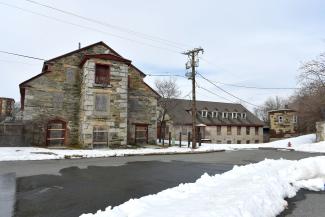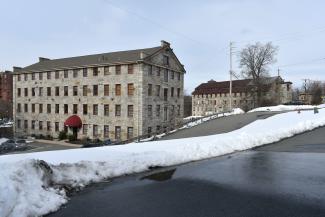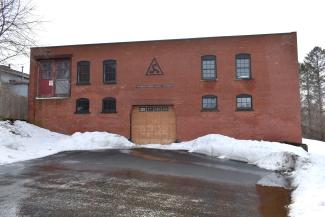Generating Electricity and Redevelopment in Woonsocket
Published on Monday, June 13, 2022
(Woonsocket, R.I.) Jeffrey Emidy, Interim Executive Director of the Rhode Island Historical Preservation & Heritage Commission, announced that the National Park Service has clarified the boundaries of the Woonsocket Company/Bernon Mills Historic District and added information to the National Register of Historic Places nomination for this Woonsocket property. The National Register is the Federal Government’s official list of properties throughout the United States whose historical and architectural significance makes them worthy of preservation. Originally listed in 1973, the history of the historic district has been reevaluated to include three additional buildings. New documentation describes the transition from manufacturing textiles to generating electricity on the property.
The Woonsocket Company/Bernon Mills Historic District is located on a 3.74-acre parcel between the Blackstone River and Front Street in the heart of Woonsocket. Buildings include the No. 1 Mill (built 1827-28), No. 2 Mill (1833), No. 4 Mill (1859), cobbler shop (built before 1911), garage (c. 1904), part of the concrete power house (ca. 1903-11), and the gatehouse (2007), as well as the remnant of the power trench (ca. 1827). It is a well-preserved example of 19th-century textile mill construction later adapted for 20th-century hydropower production.
When the property was listed in 1973, the National Register nomination focused on the 19th-century textile companies that occupied the site. In 1827-28, the Russell Manufacturing Company erected a mill, but their business failed in the depression of 1829. The Woonsocket Company acquired the property in 1831 and built three more textile mills by 1859. This firm employed a workforce of about 275 and produced between two and three million yards of cotton cloth per year. In 1883, Woonsocket Company was dissolved and the mill sat vacant for the next four years.
In 1887, the property was purchased by Woonsocket Electric Machine and Power Company (WEM&P), the city’s local lighting utility. Portions of the plant were leased to textile manufacturers, and this pattern would continue into the 1970s. Other existing buildings were repurposed and new buildings erected for hydroelectric generation. Awarded a contract to light Woonsocket, the company installed 283 arc and 4775 incandescent lights in the city by 1892 and also supplied lights and service to nearby Blackstone, East Blackstone and Millville, Massachusetts. With demand for electricity growing, WEM&P updated their facility, filling in a portion of the riverbank, extending the steam station, and erecting a new garage and power plant.
In 1912, WEM&P merged with three Woonsocket- and Pawtucket-based public utilities to create Blackstone Valley Gas & Electric Company (BVG&E). The new firm would supply gas and electricity to most Rhode Island communities in the Blackstone Valley, serving a population of about 150,000. Between the world wars, BVG&E helped drive the modernization of the Valley’s industrial base. Divested of its gas division in the late 1950s, the utility was renamed Blackstone Valley Electric Company (BVE) in 1965. Although Blackstone Valley Electric moved most of its operations to a new facility in Lincoln, they continued to use two of the Woonsocket mills for office space and equipment storage into the 1970s.
After BVE left, the buildings housed light industrial uses, including Hemond Building Specialties and Woonsocket Weaving Company, and later served as storage space. Between 2005 and 2007, Mill no. 2 was converted to residential condominium units, and new landscaping and a gatehouse were installed. The No. 1 and No. 4 mills, garage, and former shoe repair shop are currently vacant and awaiting redevelopment.
Developer Hammad Graham of Brisa Ventures LLC described the project as “one of the most compelling projects we have worked on to date,” adding “Brisa has a chance to create 60 new units of workforce housing at Bernon Mills, and potentially commercial and office space as well a recreational facility in a second phase. From the very beginning, the project team believed that Bernon Mills deserved to be redeveloped.”
RIHPHC’s Interim Executive Director Jeffrey Emidy commented, “The Woonsocket Company mill complex is profoundly important architecturally, as the oldest surviving example of slow-burning mill construction in the country. Textile manufacturing was integral to Woonsocket’s economy throughout the nineteenth and early twentieth centuries. Recognizing the complex’s later use in the establishment of the electrical generation system of the Blackstone Valley sheds light on a rarely considered, but incredibly important, aspect of our history.”
The National Register documentation was prepared by Ryan Cameron of MacRostie Historic Advisors. In addition to honoring a property for its contribution to local, state, or national history, listing on the National Register provides additional benefits. It results in special consideration during the planning of Federal or federally assisted projects and makes properties eligible for Federal and Rhode Island tax benefits for historic rehabilitation projects. Owners of private property listed on the National Register are free to maintain, manage, or dispose of their property as they choose. As the state office for historic preservation, the RIHPHC is responsible for reviewing and submitting Rhode Island nominations to the National Register.


